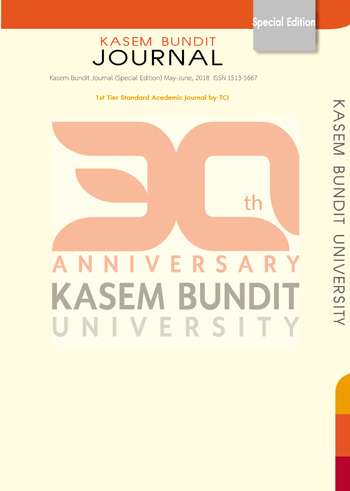ESG and Impact investing in Thailand: the case of Siam Cement Group
Keywords:
ESG, Impact Investing, Triple Bottom Line, Responsible InvestingAbstract
This paper focuses on two newly emerging popular investment tools used by corporations in the domain of triple bottom line (TBL): ESG, or environmental, social and governance matters and Impact investing (II), an emergent tool, which came to denote the type of investing aiming specifically at achieving two objectives – financial returns and positive social impact [12]. The two differ in screening methods ranging from more impact driven in II as opposed to value driven ones under ESG. The article describes the theoretical framework of ESG and II and the application of the tools on the evidence from the Siam Cement Group PCL in Thailand. The SCG case is explored from the point of view of screening methods and effects of the company’s main investment project in the domain of TBL.
References
2 Bauer, R., & Hann, D. (2010). Corporate Environmental Management and Credit Risk. SSRN Electronic Journal, 1–44. http://doi.org/10.2139/ssrn.1660470
3 Bauer, R., Clark, G. L., & Viehs, M. (2013). The Geography of Shareholder Engagement : Evidence from a Large British Institutional Investor *, 1–53.
4 Bowen, H. R. (1953). Social Responsibilities of the Businessman. New York: Harper and Row
5 Cable News Network. A Time Warner Company. (2013). Fortune | 100 Best Companies to Work for: Google. Retrieved from http://money.cnn.com/magazines/fortune/best-companies/2013/snapshots/1.html?iid=bc_sp_list
6 Clark, G. L., & Salo, J. (2008). Corporate Governance and Environmental Risk Management: A Quantitative Analysis of “New Paradigm” Firms. Pensions at Work: Socially Responsible Investment of Union-Based Pension Funds, (February). Retrieved from http://www.ouce.ox.ac.uk/research/spaces/wpapers/wpg06-05.html
7 Crane, A. McWilliams, D. Matten, J. Moon, D. Siegel, eds., pp. 413‐431, Oxford University Press, 2008.
8 Davies Keith (1960), “Can Business Afford to Ignore Social Responsibilities?” California Management Review, 2 (Spring), 70-76.
9 Derwall, J., & Horst, J. Ter. (2010). A Tale of Values- Values -Driven and Profit, 1–14.
10 Dowell, G., Hart, S., & Yeung, B. (2000). Do Corporate Global Environmental Standards Create or Destroy Market Value? Management Science, 46(February), 1059–1074. http://doi.org/10.1287/mnsc.46.8.1059.12030
11 Elkington, J. (1997). Cannibals with forks. The Triple Bottom Line of 21st Century, (April), 1–16. http://doi.org/http://doi.wiley.com/10.1002/tqem.3310080106
12 Eurosif. (2014). European SRI Study.
13 Friedman, M., 1970. The Social Responsibility of Business Is to Increase Its Profits, Corporate Ethics and Corporate Governance, 173-178
14 Fulton, M., Kahn, B. M., & Sharples, C. (2012). Sustainable Investing: Establishing Long-Term Value and Performance, (June), 1–72. http://doi.org/http://dx.doi.org/10.2139/ssrn.2222740
15 Gompers, P., Ishii, J., Metrick, A., 2003. Corporate governance and equity prices. Quarterly Journal of Economics 118, 107–155.
16 Kristoffersen, I., Gerrans, P., & Clark-murphy, M. (2005). The Corporate Social Responsibility and the Theory of the Firm. FIMARC Working Paper Series, 24.
17 McKee J., Neighbors H., Ulrich G. (2012) Gateways to Impact. Calvert Foundation. www.gatewaystoimpact.org
18 Mercer. (2007). The language of responsible investment: An industry guide to key terms and organizations.
19 Murphy, P., & Schif, H. (2014). Iris Data Brief: Focus on Impact Objectives, 1–9.
20 OECD. (2007). The UN Principles for Responsible Investment and the OECD Guidelines for Multinational Enterprises: Complementarities and Distinctive Contributions, (June), 1–12.
21 Probus Sigma. (2015). ESG as an Investment Tool. Retrieved from http://www.probus-sigma.com/wp-content/uploads/downloads/2012/09/ESG-As-an-Investment-Tool.pdf
22 Reading, R., & Hart, S. (1993). Annotated Bibliography on “The Relevance of ESG Issues from the Standpoint of Large Institutional Investors: A Specific Focus on Emerging Markets .,” (pg 5), 1–44.
23 SCG Sustainability report 2016. SCG, 2016.
24 SCG Sustainability report 2017. SCG, 2017.
25 Scherer, Andreas Georg and Palazzo, Guido,Globalization and Corporate Social Responsibility. The Oxford Handbook of Corporate Social Responsibility.
26 WCED, 1987. Our common future. Report of the World Commission on Environment and Development. G. H. Brundtland, (Ed.). Oxford: Oxford University Press
27 http://www.scg.com.
Downloads
Published
How to Cite
Issue
Section
License
ทัศนคติ ความคิดเห็นใด ๆ ที่ปรากฏในวารสารเกษมบัณฑิตฉบับนี้เป็นของผู้เขียน โดยเฉพาะ มหาวิทยาลัยเกษมบัณฑิตและบรรณาธิการ ไม่จำเป็นต้องมีความเห็นพ้องด้วย







